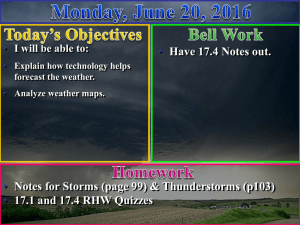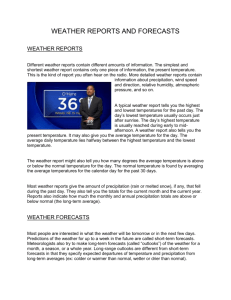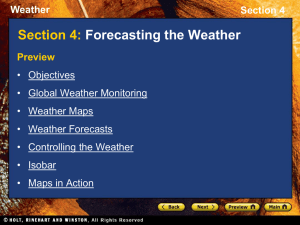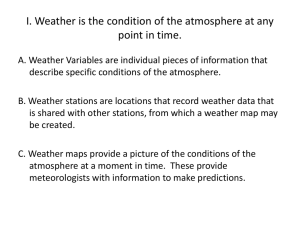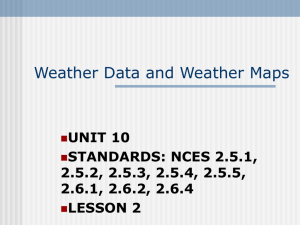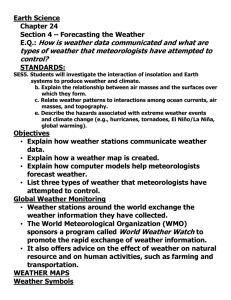Lesson 5
advertisement
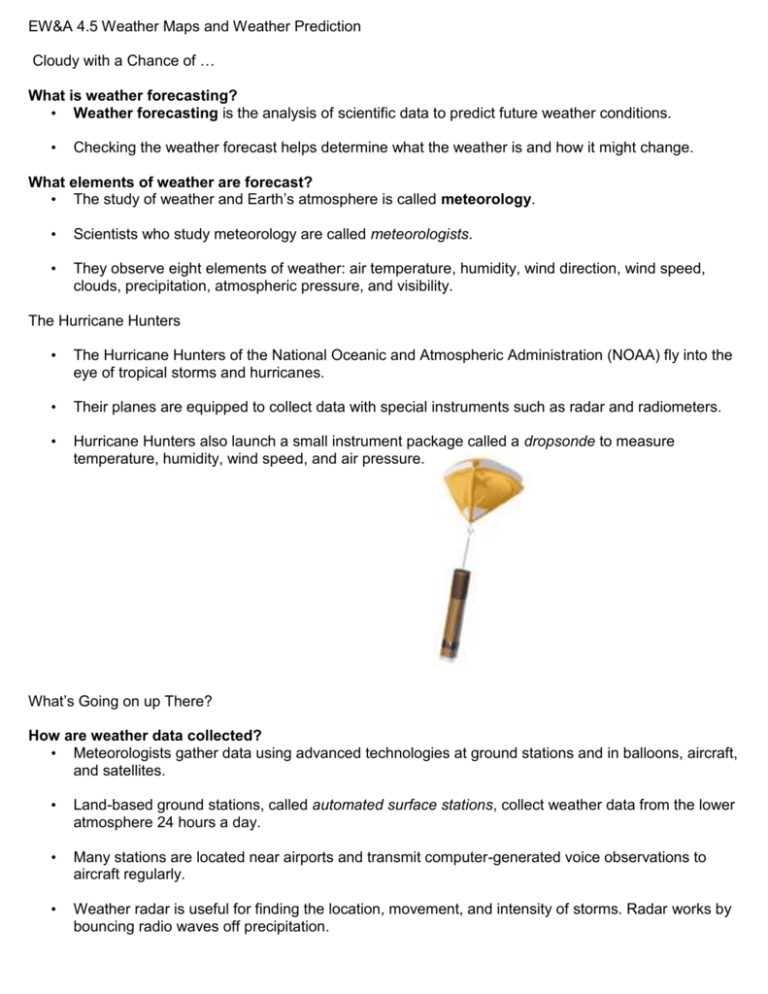
EW&A 4.5 Weather Maps and Weather Prediction Cloudy with a Chance of … What is weather forecasting? • Weather forecasting is the analysis of scientific data to predict future weather conditions. • Checking the weather forecast helps determine what the weather is and how it might change. What elements of weather are forecast? • The study of weather and Earth’s atmosphere is called meteorology. • Scientists who study meteorology are called meteorologists. • They observe eight elements of weather: air temperature, humidity, wind direction, wind speed, clouds, precipitation, atmospheric pressure, and visibility. The Hurricane Hunters • The Hurricane Hunters of the National Oceanic and Atmospheric Administration (NOAA) fly into the eye of tropical storms and hurricanes. • Their planes are equipped to collect data with special instruments such as radar and radiometers. • Hurricane Hunters also launch a small instrument package called a dropsonde to measure temperature, humidity, wind speed, and air pressure. What’s Going on up There? How are weather data collected? • Meteorologists gather data using advanced technologies at ground stations and in balloons, aircraft, and satellites. • Land-based ground stations, called automated surface stations, collect weather data from the lower atmosphere 24 hours a day. • Many stations are located near airports and transmit computer-generated voice observations to aircraft regularly. • Weather radar is useful for finding the location, movement, and intensity of storms. Radar works by bouncing radio waves off precipitation. • The stronger the returning signal, the heavier the precipitation is. The longer it takes for the signal to return, the farther away the precipitation is. • Doppler radar is important for detecting and tracking severe storms and tornados. • Aircraft can carry a variety of weather-sensing instruments and collect data in places far from ground stations, such as over oceans. • Weather balloons carry a small instrument package called a radiosonde. • Radiosondes measure atmospheric pressure, air temperature, humidity, and wind speed and direction, up to about 32 km. • Orbiting weather satellites provide data on water vapor, cloud-top temperatures, and the movement of weather systems. • Geostationary weather satellites monitor Earth from a fixed position thousands of kilometers above Earth. • Polar-orbiting satellites circle Earth and provide global information from hundreds of kilometers above Earth’s surface. What kinds of symbols and maps are used to analyze the weather? • A station model is a set of meteorological symbols that represent the weather at a particular observing station. • A station model is a small circle surrounded by a set of symbols and numbers that represent current weather data at a specific site. • Placing many station models on a map makes it possible to see large weather patterns, such as fronts. How would this station model change if the sky became completely overcast and winds blew from the south at 10 knots? • Meteorologists commonly use surface weather maps to show forecasts. The map displays air pressure and the locations of fronts. • Air pressure is shown by using isobars, which are lines that connect points of equal air pressure, marked in units called millibars. • Cold fronts are shown using blue lines and blue triangles. Warm fronts are shown using red lines and red half-circles. What can you conclude from this weather map about the weather happening in different parts of the United States? • Another type of weather map used to analyze weather is the upper-air chart, based on data collected by weather balloons. • Upper-air charts show wind and air pressure at middle and upper levels of Earth’s atmosphere. • Information from these charts indicates if and where weather systems will form, and if they will move, remain stationary, or fall apart. The National Weather Service has Issued a Severe Storm Warning… What are some types of weather forecasts? • Short-range weather forecasts make predictions 0 to 3 days into the future. Medium-range forecasts predict conditions 3 to 7 days into the future. • Temperature, wind, cloud cover, and precipitation are predicted with different degrees of accuracy. • Weather forecasting is an imperfect science. Many variables affect weather, all of which are changing constantly. Long-range forecasts can range from weeks to months into the future. • • Using sea surface temperatures and high-level winds, forecasters can make general predictions about the future. • They can predict if the weather will be warmer or colder or wetter or drier than average, but not the temperature or rainfall on a particular day. Hazardous weather forecasts include weather advisories, weather watches, and weather warnings. • • A weather advisory is issued when the expected weather conditions will not be a serious hazard but may cause inconvenience. • • A weather watch is issued when severe weather conditions are possible over a large area. People should have a plan of action in case of a storm. A weather warning is issued when weather conditions that pose a threat to life and property are happening or are about to happen. • Those who live in the path of the storm need to take immediate action.
